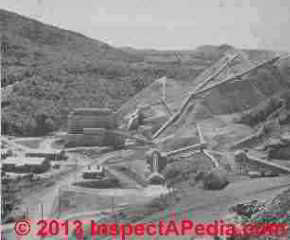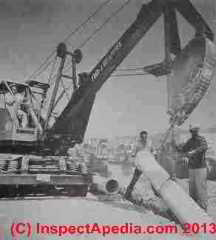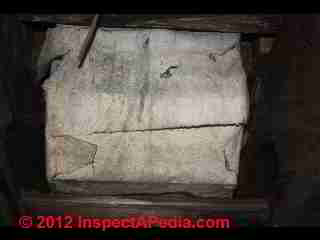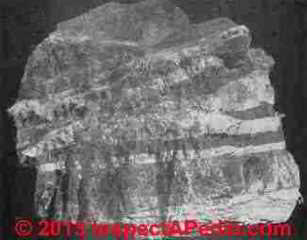 Asbestos, Its History, Properties, Industrial Applications
Asbestos, Its History, Properties, Industrial Applications
History, Manufacture &
Identification of Asbestos
- POST a QUESTION or COMMENT about this article topic.
Asbestos: what is asbestos, where does it originate, how has it been mined & used to manufacture products from ancient to modern times.
Where has asbestos been mined around the world, where are the principal asbestos deposits?
How is asbestos graded or classified - fiber lengths. Asbestos health issues ca 1959. Where do asbestos reserves remain? What are the principal product groups that used asbestos? This chapter forms the introduction to Rosato's Asbestos, its Industrial Applications (1959) [1].
This articles series about the manufacture & use of asbestos-containing products includes detailed information on the production methods, asbestos content, and the identity and use of asbestos-containing materials.
InspectAPedia tolerates no conflicts of interest. We have no relationship with advertisers, products, or services discussed at this website.
- Daniel Friedman, Publisher/Editor/Author - See WHO ARE WE?
Asbestos Sources, Origins, Uses, History & Contemporary Asbestos Concerns
 Preface
Preface
In the more than half a centruy since Rosato published his enthsiastic little red book about asbestos this natural mineral has experienced a turbulent history that included valuable uses across thousands of products around the world and ultimately high costs of personal illness and asbestos cleanup projects. Asbestos remains in many products and buildings, in some cases in hazardous forms in other cases probably not.
[Click to enlarge any image]
That asbestos remains a controversial material was evident in a New York Times article reported in February 2015. There the Times reported
Asbestos occurs naturally in many parts of the country, mostly in the West but also along some mountain ranges n the East. But in Nevada, the scientists found, natural erosion and commercial development were sending these fibers into the wind. ...
With data from Nevada's cancer registry, an epidemiologist prepared a preliminary report that outlining [sic] what she felt was a troubling pattern of mesothelioma - a cancer often related to asbestos exposure - among residents of the affected areas.
... Upon learning of the report, the Nevada Department of Health forced the epidemiologist, Francine Baumann of the University of Hawaii, to withdraw a presentation of the findings at a scientific conference and revoked her access to the state cancer registry. ... The department's own analysis has turned up no particular asbestos risks to residents, the officials say ...
In her original review of data from the state cancer registry, Dr. Baumann says she found an unusual number of mesothelioma cases in younger residents and in women in the affected areas. The disease usually occurs in older men, after years of on-the-job exposure. ...
She submitted the abstract to the Geological Society of America and was to present it at the group's national meeting in 2012. ... the [Nevada] state health officer, Dr. Tracey Green, ... demanded that the abstract be taken off the website, and the presentation was cancelled.... She said it was necessary because Dr. Baumann ... [wanted to] publish a misguided study.
On [10 February 2015] Dr. Baumann and her colleagues, using cancer data from the U.S. Centers for Disease Control and Prevention for confirmation, published a study in the Journal on Thoracic Oncology finding elevated rates of mesothelioma among adults under age 55 in southern Nevada and concluding that it may be linked to naturally occurring asbestos.
Some of the cases were teenagers, the authors reported, and the disease is occurring more frequently among women in southern Nevada than elsewhere. - Blum, Deborah, "A Controversy in the Wind: Scientists and state officials disagree over a natural asbestos risk in Nevada", The New York Times, 10 February 2015 p. D1, D4.
Also see ASBESTOS MINE LOCATIONS
The following text is Adapted from Rosato (1959) p. iii-iv & 1-36. [1] © 2013 InspectApedia.com
D. V. Rosato, Engineering Consultant Newton, Massachusetts (1959), edited, adapted, expanded (1985-2013)
 This book discusses the many varied applications of asbestos.
Its purpose is to provide background as well as
factual information on the uses of asbestos. Asbestos is
utilized in a wide range of products, though its identity is
often obscured. The discussion in this book is primarily concerned
with the more familiar specialized products.
This book discusses the many varied applications of asbestos.
Its purpose is to provide background as well as
factual information on the uses of asbestos. Asbestos is
utilized in a wide range of products, though its identity is
often obscured. The discussion in this book is primarily concerned
with the more familiar specialized products.
Asbestos can be classified both as an old product and as a new one. History has justified its usefulness. The accelerated pace at which technology is advancing in this atomic and space age has created many new demands on basic materials and the need for developing new and improved products at a more rapid rate.
The technological advances in the use of asbestos have produced some large and important industries. This does not mean that asbestos will supplant other established materials, any more than it can be expected that other products will eliminate asbestos.
The possibility of new uses for asbestos is far from exhausted. Because of such technical advances and scientific research, diversified products have been developed. Valuable new properties of asbestos have been determined, which in turn account for its many new applications. These, as well as improved products, are included in this volume.
Photo at left, Asbestos cement pipe. (Courtesy Johns-Manville Corp.)
The increase in asbestos products in the past 2,000 years has been a milestone in world growth. The atomic age has been reached as a result of the achievements made in working with such materials as asbestos. Asbestos used in conjunction with new chemicals continues to make important contributions to industry. The combined effort of special military agencies and industry has resulted in its continual growth in diversified fields; ingenious methods have been developed to utilize this material.
This book will serve as a guide to various branches of industry—research and development groups, manufacturers, educational institutions, market research groups, and sales management
. Its purpose is to better acquaint industry with asbestos products in the fields of building materials, insulation, electrical units, chemical units, asbestos-cements, filters, friction materials, packings, adhesives, lubricants, plastics, machinery, paper, medicine, etc.
In order to do this, it is necessary that a review be made of the types of materials that are available, their properties, and the methods of manufacturing them. Such a review will help the reader to have a better understanding of the variables which exist in working with this material. In most applications, where asbestos is used, the products are superior to other materials.
This book is designed to present the various industrial applications, and an over-all view of the methods of fabrication. It is hoped that this book will stimulate further re- search in the use of asbestos, particularly more fundamental basic research.
Material has been derived from many sources. The data are based on observation and published references. The author wishes to thank the many companies that have contributed to the preparation of this volume.
- D.V. Rosato, Newton Mass, May, 1959 [edited, expanded, illustrated, D J Friedman 1985 - 2013]
The Origin and Nature of Asbestos
 Asbestos is the name given to the serpentine and amphibole
groups of fibrous inorganic minerals that occur in different
forms and in different parts of the world. The most important
group is chrysotile which represents approximately 95
per cent of the total world production of all asbestos.
Asbestos is the name given to the serpentine and amphibole
groups of fibrous inorganic minerals that occur in different
forms and in different parts of the world. The most important
group is chrysotile which represents approximately 95
per cent of the total world production of all asbestos.
Photo at left: asbestos paper on HVAC ducts served as both insulation and a seal against air leaks. See ASBESTOS PAPER DUCT INSULATION for details.
The most important deposits are in Canada. Asbestos has been recorded in literature from the days of the Romans, but it was not mined and used in large quantities until the deposits in Canada were made available in 1878. Canada produces approximately 60 per cent of the world's asbestos with 95 per cent being of the chrysotile type.
Geologists refer to asbestos as material transformed from special rocks (serpentine), twisted and squeezed by prehistoric volcanoes millions of years ago.
Masses of molten rock passed through the earth's crust; mineral-rich ocean waters rushed through the cracks and crevices. As the earth's internal heat and pressure developed, these openings filled up with crystals developed from the passing water.
The asbestos filled cracks and crevices are referred to as veins in the rock. These veins sometimes occur on the surface of the earth. But more frequently, they are deep in the ground. Asbestos is obtained from surface or tunnel mining. After it has been mined, the tightly packed asbestos fibers go td mills where they are fiberized and cleaned.
Chrysotile is a serpentine mineral and the most important form of asbestos. Its formula is 3MgO.2SiO2.2H20. Its main chemical compositions are Si02 and MgO. Other compositions of asbestos include 1120, FcO, Fe 2 0 and Al23.
 Asbestos is a mineral; however, it can be separated into
the finest man made or natural flexible fiber. Single fiber
diameters can be obtained as fine as 0.0000007 in. It will not
burn or rot; it resists heat and chemicals.
Asbestos is a mineral; however, it can be separated into
the finest man made or natural flexible fiber. Single fiber
diameters can be obtained as fine as 0.0000007 in. It will not
burn or rot; it resists heat and chemicals.
Shown at left, asbestos ore. Rosato (1959)
Because it combines these properties with other advantageous properties, asbestos is now an important industrial product for both regular and specialized products, the manufacture of which constitutes a vast industry. In most cases, asbestos loses its identity in the finished product; in more than 95 per cent of its applications, it is combined with other products to produce such items as tile, gaskets, plastics, cements, and filters.
The [asbestos] fiber-bearing rocks contain [asbestos] fibers of various lengths. The shorter fibers are more abundant; they are used in the largest single asbestos industry; i.e., for such asbestoscement products as siding shingles, fiat sheets, roofing shingles and corrugated sheets.
The longer asbestos fibers are used primarily in the manufacture of such textile products as yarn, cloth, tape, felt and lap. These constitute the second largest use for asbestos. The principal method of obtaining asbestos for the textile industry involves hand picking operations at the mine. However, special fiberizing processes at the textile mill are of prime importance in the manufacture of the end products.
Origin of Asbestos
One of the theories of the formation of asbestos involves the result of volcanic activity which occurred many hundreds of thousands of years ago. The igneous rocks had acidic inclusions that formed granites and feldspar dikes. The basic inclusions formed dunite which eventually formed peridotite and pyroxene peridotite after coming in contact with olivine and oxides.
Through the ages, these rocks passed through various stages of physical and chemical changes and formed minerals known as serpentine. This change occurred when high pressure caused cracks in the rock. In turn, these cracks were filled with hot ground waters derived from the infiltration of rain or surface waters. The continued infiltration of this water under heat and pressure caused the water to become contaminated with various minerals. Crystals developed and were deposited in the cracks.
The rock formation in Canada is a variety of olivine which is composed of iron, magnesia, and silicate. Water containing carbon dioxide and salt in solution penetrated the rocks. This gradual flow of highly contaminated water changed the original rock from an iron-containing mineral to a magnesia-silica-iron solution. According to the geologist, this reaction took place thousands of feet below present elevation.
It is believed that asbestos developed deep within the earth where conditions of high pressure and heat existed. Since in the case of the North American Continent asbestos is found on the surface, it is assumed that the glaciers or massive ice formations removed the overburden of earth.
The importance and commercial value of asbestos is attributed both to its incombustibility and to its unique structure. It is fibrous, having been created by a natural process which man has not been able to reproduce. In a sense, it is a mineral silk, un-decayed and unaltered by time or weather.
Asbestos is an enemy of heat, flame, chemicals and acids. In addition, it is resistant to moisture and corrosion. Asbestos fibers can be individually fiberized and handled in a manner similar to such fibers as those of animal origin ( wool and silk) and those of vegetable origin (cotton and flax). To the physicists and scientists, asbestos is of especial interest, inasmuch as it is both fibrous and crystalline.
Other Resources: History of Asbestos
- ASBESTOS CEMENT ROOF & SIDING HISTORY
- Bowles, Oliver. ASBESTOS [PDF] (book) No. 403. US Government Printing Office, 1937.
Introduction excerpt:
The mineral asbestos, because of its unique fibrous character, is allied to cotton and wool but has the advantage of heat and fire resistance; therefore, it supplies many industrial needs for which no substitutes are yet available. This report covers the essential features of the asbestos industry, including occurrence , production, mining, milling, utilization, international trade, and marketing.
The United States leads all countries in the manufacture of asbestos products, but domestic sources furnish only a small fraction of the raw material required . As the United States is dependent to so great an extent on foreign supplies of raw materials, the bulletin deals at length with the asbestos industry in foreign lands.
Excerpt:
The utilization of asbestos on a commercial scale had its real be ginning in Italy. About 1808, a noblewoman of Valtellina sponsored studies and experiments that brought her many honors and led to the manufacture of asbestos thread ,fabrics, and paper of high qual ity. Several companies were formed between 1860 and 1875. No serious problems were involved in the manufacture of rope packings and heat- insulating board, but much difficulty was encountered in devising suitable machinery for the fabrication of spun products .
Exhibits at the Universal Exposition in Paris in 1878 gave wider publicity to the products then manufactured.
In 1860 asbestos was discovered near St. Joseph in Quebec, Canada, and a specimen of fine silky fiber from this region was exhibited in London in 1862. - CEILING TILE HISTORY / DATES - asbestos ceiling tile history & Dates
- CELOTEX HISTORY & PRODUCTS
- DRYWALL & GYPSUM BOARD COMPOSITION & HISTORY
- FLOOR TILE HISTORY & INGREDIENTS - home
- HISTORY & DATES OF ASBESTOS CONTAINING MATERIAL BANS & REGULATIONS
- VERMICULITE HISTORY & PROPERTIES
...
Continue reading at ASBESTOS MINE LOCATIONS or select a topic from the closely-related articles below, or see the complete ARTICLE INDEX.
Or see these
Recommended Articles
- ASBESTOS, ITS INDUSTRIAL APPLICATIONS, ROSATO 1959
- ASBESTOS ORIGIN & NATURE - p. 1-36
- ASBESTOS PROPERTIES - p. 37-61
- ASBESTOS CEMENT PRODUCTS - p. 62-66
- CEMENT ASBESTOS PRODUCT MANUFACTURE - p. 66-73
- CEMENT ASBESTOS PRODUCT CURING - p. 73-75
- CEMENT ASBESTOS SHEET PRODUCTS - p. 75-78
- CEMENT ASBESTOS PIPE MANUFACTURE - 78-85
- ASBESTOS TILE MANUFACTURE - p. 86-93
- ASBESTOS INSULATION - 94-105
- ASBESTOS ELECTRICAL WIRE INSULATION - p. 106-112
- ASBESTOS FRICTION MATERIALS - p. 113-129
- ASBESTOS TEXTILES - p. 130-141
- ASBESTOS in PLASTICS - p. 142-177
- ASBESTOS PACKINGS & GASKETS - p. 178-184
- ASBESTOS FILTERS - p. 185-193
- ASBESTOS OTHER PRODUCTS - p. 194-200
- ASBESTOS BIBLIOGRAPHY - p. 201-207
Suggested citation for this web page
ASBESTOS ORIGIN & NATURE at InspectApedia.com - online encyclopedia of building & environmental inspection, testing, diagnosis, repair, & problem prevention advice.
Or see this
INDEX to RELATED ARTICLES: ARTICLE INDEX to ASBESTOS HAZARDS
Or use the SEARCH BOX found below to Ask a Question or Search InspectApedia
Ask a Question or Search InspectApedia
Try the search box just below, or if you prefer, post a question or comment in the Comments box below and we will respond promptly.
Search the InspectApedia website
Note: appearance of your Comment below may be delayed: if your comment contains an image, photograph, web link, or text that looks to the software as if it might be a web link, your posting will appear after it has been approved by a moderator. Apologies for the delay.
Only one image can be added per comment but you can post as many comments, and therefore images, as you like.
You will not receive a notification when a response to your question has been posted.
Please bookmark this page to make it easy for you to check back for our response.
IF above you see "Comment Form is loading comments..." then COMMENT BOX - countable.ca / bawkbox.com IS NOT WORKING.
In any case you are welcome to send an email directly to us at InspectApedia.com at editor@inspectApedia.com
We'll reply to you directly. Please help us help you by noting, in your email, the URL of the InspectApedia page where you wanted to comment.
Citations & References
In addition to any citations in the article above, a full list is available on request.
- Rosato, D.V., Asbestos, its Industrial Applications, D.V. Rosato, engineering consultant, Newton MA, Reinhold Publishing Co., NY, 1959, Library of Congress Catalog No. 59-12535. Excerpts & adaptations are found in InspectApedia.com articles on asbestos history, production & visual identification in and on buildings.
Re-printed online with additional annotations, photos, and information, beginning at
ASBESTOS, ITS INDUSTRIAL APPLICATIONS, ROSATO 1959 - [2] "Asbestos in Plastic Compositions", A.B. Cummins, Modern Plastics [un-dated, pre 1952]
- [3] "Asbestos in Your Home," Spokane County Air Pollution Control Authority, Spokane WA 509-477-4727 www.scapa.org provides a one-page image, a .pdf file drawing of a house warning of some possible sources of asbestos in the home. The sources are not ranked according to actual risk of releasing hazardous levels of airborne asbestos fibers and the list is useful but incomplete.
- [4] The US EPA provides a sample list of asbestos containing products epa.gov/earth1r6/6pd/asbestos/asbmatl.htm
- [5] "Characterization of asbestos exposure among automotive mechanics servicing and handling asbestos-containing materials", Gary Scott Dotson, University of South Florida, 1 June 2006, web search 3/9/2012 original source: scholarcommons.usf.edu/cgi/viewcontent.cgi?article=3505&context=etd [copy on file as /hazmat/Automotive_Asbestos_Exposure.pdf ].
- [6] Asbestos Identification and Testing References
- Asbestos Identification, Walter C.McCrone, McCrone Research Institute, Chicago, IL.1987 ISBN 0-904962-11-3. Dr. McCrone literally "wrote the book" on asbestos identification procedures which formed the basis for current work by asbestos identification laboratories.
- Stanton, .F., et al., National Bureau of Standards Special Publication 506: 143-151
- Pott, F., Staub-Reinhalf Luft 38, 486-490 (1978) cited by McCrone
- [6] ASBESTOS IN YOUR HOME U.S. EPA, Exposure Evaluation Division, Office of Toxic Substances, Office of Pesticides and Toxic Substances, U.S. Environmental Protection Agency, Washington,D.C. 20460
- [7] Asbestos products and their history and use in various building materials such as asphalt and vinyl flooring includes discussion which draws on ASBESTOS, ITS INDUSTRIAL APPLICATIONS, ROSATO 1959, D.V. Rosato, engineering consultant, Newton, MA, Reinhold Publishing, 1959 Library of Congress Catalog Card No.: 59-12535 (out of print, text and images available at InspectAPedia.com).
- [8] "Handling Asbestos-Containing roofing material - an update", Carl Good, NRCA Associate Executive Director, Professional Roofing, February 1992, p. 38-43
- [9] EPA Guidance for Controlling Asbestos-Containing Materials in buildings, NIAST, National Institute on Abatement Sciences & Technology, [republishing EPA public documents] 1985 ed., Exposure Evaluation Division, Office of Toxic Substances, Office of Pesticides and Toxic Substances, U.S. Environmental Protection Agency, Washington,D.C. 20460
- EPA ASBESTOS MATERIALS BAN: CLARIFICATION 1999
- Basic Information about Asbestos, US EPA, web search 08/17/2010, original source: http://www.epa.gov/asbestos/pubs/help.html
- "Handling Asbestos-Containing roofing material - an update", Carl Good, NRCA Associate Executive Director, Professional Roofing, February 1992, p. 38-43
- EPA Guidance for Controlling Asbestos-Containing Materials in buildings, NIAST, National Institute on Abatement Sciences & Technology, [republishing EPA public documents] 1985 ed., Exposure Evaluation Division, Office of Toxic Substances, Office of Pesticides and Toxic Substances, U.S. Environmental Protection Agency, Washington,D.C. 20460
- EPA, ASBESTOS IN YOUR HOME [PDF] - U.S. EPA, Exposure Evaluation Division, Office of Toxic Substances, Office of Pesticides and Toxic Substances, U.S. Environmental Protection Agency, Washington,D.C. 20460
- Vermiculite:
Protect Your Family from Asbestos-Contaminated Vermiculite Insulation, U.S. EPA , web search 08/17/2010, original source: http://www.epa.gov/asbestos/pubs/verm.html
Web search 01/20/2011, original source: http://epa.gov/asbestos/pubs/verm_questions.html - Proteja su familia del aislante de vermiculita contaminado con asbesto, U.S. EPA HOJA INFORMATIVA - Proteja a su familia del aislante de vermiculita contaminado con asbestos, web search 08/17/2010, original source http://www.epa.gov/asbestos/pubs/verm-ques-sp.pdf
- [copy on file as /hazmat/Vermiculite_US_EPA.pdf/ Current Best Practices for Vermiculite Attic Insulation - May 2003, U.S. EPA
- [copy on file as] /hazmat/Vermiculite_Health_Canada.pdf] Vermiculite Insulation Containing Amphibole Asbestos - September 2009, Health Canada
- Managing Asbestos in Place, How to Develop and Maintain a Building Asbestos Operations and Maintenance (O&M) Program, U.S. EPA, web search 01/20/2011, original source: http://www.epa.gov/asbestos/pubs/management_in_place.html
- Asbestos Strategies, Lessons Learned about Management and Use of Asbestos: Report of Findings and Recommendations on the Use and Management of Asbestos, 16 May 2003, US EPA, web search 01/20/2011, original source: http://www.epa.gov/asbestos/pubs/asbstrategiesrptgetf.pdf
prepared by the: Global Environment & Technology Foundation, 7010 Little River Turnpike, Suite. 460, Annandale VA 20003 - Other US EPA Publications on asbestos: web search 01/20/2011, see http://www.epa.gov/asbestos/pubs/pubs.html
- In addition to citations & references found in this article, see the research citations given at the end of the related articles found at our suggested
CONTINUE READING or RECOMMENDED ARTICLES.
- Carson, Dunlop & Associates Ltd., 120 Carlton Street Suite 407, Toronto ON M5A 4K2. Tel: (416) 964-9415 1-800-268-7070 Email: info@carsondunlop.com. Alan Carson is a past president of ASHI, the American Society of Home Inspectors.
Thanks to Alan Carson and Bob Dunlop, for permission for InspectAPedia to use text excerpts from The HOME REFERENCE BOOK - the Encyclopedia of Homes and to use illustrations from The ILLUSTRATED HOME .
Carson Dunlop Associates provides extensive home inspection education and report writing material. In gratitude we provide links to tsome Carson Dunlop Associates products and services.

